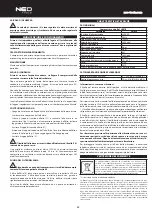
neo-tools.com
neo-tools.com
9
EXPLANATION OF USED SYMBOLS
1
2
3
4
5
6
7
8
9
10
11
12
1.
Read the manual
2.
Use protective clothing
3.
Use protective glasses and hearing protectors, use protective mask
4.
Protect against rain
5.
Unplug the device before repair (maintenance)
6.
For use indoors
7.
Caution, hot surfaces
8.
Caution, may start unexpectedly
9.
Caution, risk of electric shock
10.
Risk of body injury with high pressure
11.
Do not direct stream onto people, animals or live installations
12.
Keep the tool away from children
DESIGN AND INTENDED USE
The compressor driven with electric motor is a device whose main and only
function is air compression and holding atmospheric air. Pressurised air can
be used to drive pneumatic tools, pump air containers, spraying liquids or
blowing through hard to reach places. It is intended for amateur use only.
The compressor is designed for intermittent operation to avoid overheating,
which means it should operate at 1 duty period then 3 resting periods (e.g.:
2.5 min. operation and 7.5 min. rest).
THE COMPRESSOR IS NOT DESIGNED FOR OUTDOOR USE
USE THE COMPRESSOR ONLY IN VERTICAL POSITION.
Use the compressor according to the manufacturer’s instructions
only.
DESCRIPTION OF DRAWING PAGES
Below enumeration refers to the device elements depicted on the drawing
pages of this manual.
1.
ON/OFF switch
2.
Compressed air connection (quick coupler)
3.
Safety valve
4.
Manometer (shows pressure inside the tank)
5.
Pressure adjustment valve (reduction)
6.
Transport handle
7.
Manometer (shows pressure set up)
8.
Air filter
9.
Oil filler plug
10.
Oil level sight glass
11.
Oil drain plug
12.
Tank
13.
Wheel
14.
Rubber foot
15.
Drain plug for tank condensation water
* Differences may appear between the product and drawing
MEANING OF SYMBOLS
WARNING
EQUIPMENT AND ACCESSORIES
1.
Wheel
- 2 pcs
2.
Rubber foot
- 2 pcs
3.
Screws, washers, nuts - 1 set
4.
Air filter - 1 pce
5.
Oil bottle - 1 pce
PREPARATION FOR OPERATION
COMPRESSOR INSTALATION
• Power supply voltage and frequency should match parameters defined on
the compressor rating plate and in the manual.
• Residual current device is required for electrical installation, it must break
the circuit in 30 ms after earth leakage current exceeds 30 mA.
• Make sure the compressor is not damaged during transportation.
• Check oil level in the compressor oil sump.
• Place the compressor as close as possible to compressed air receiver.
• Avoid using long compressed air hoses and long power cords.
• Make sure sucked air is dry, contains no contaminants or substances that
might cause fire or explosion inside the compressor.
• Do not install the compressor in damp rooms.
• The compressor must operate on even and stable ground to allow proper
lubrication.
PREPARATING THE COMPRESSOR FOR OPERATION
• Install the wheels (13) (fig. A).
• Install the rubber feet (14) to supports (fig. B).
• Remove the oil filler plug (9) and fill the compressor with provided oil.
• Check oil level on the oil level sight glass (10) (fig. C).
• Screw the air filter (8) into the hole in the compressor head (fig. D).
Oil level should be visible in the sight glass and indicated with
red dot.
OPERATION / SETTINGS
SWITCHING ON / OFF
Switching on – set the switch lever (1) to position “ON” (down).
Switching off – set the switch lever (1) to position “OFF” (up) (fig. E).
AIR PRESSURE ADJUSTMENT
Screw the pressure adjustment valve (5) out by turning it counter-clockwise
to reduce compressor outlet pressure. Screw the pressure adjustment valve
(5) (fig. F) out by turning it clockwise to increase outlet pressure. Manometer
(7) shows the pressure value.
The manometer (4) shows the current pressure in the tank (12) (fig. G).
SAFETY VALVE
The safety valve (3) is adjusted for the maximum safe pressure
allowed by the tank design. Do not adjust the safety valve.
MAINTENANCE AND OPERATION
Unplug the power cord from mains socket and release compressed air
from the tank before commencing any activities related to installation,
adjustment, repair or maintenance.
TRANSPORT AND STORAGE
Transport or store the compressor in vertical or horizontal position thanks to
rubber feet on the handle.
MAINTENANCE
Keep the compressor clean and observe periodic maintenance actions.
CONDENSATION WATER
Before draining condensate water, disconnect the compressor from elec-
tric power supply and release air from the tank.
After a day of operation drain condensation water from the tank. Use the
drain plug for condensation water (15) located in the bottom section of the
tank (fig. H).
Visually check condition of external tank surfaces once a year. Carry out these
checks more often when the tank is used in highly humid environment or
in unfavourable conditions (insufficient ventilation, aggressive agents etc.).










































